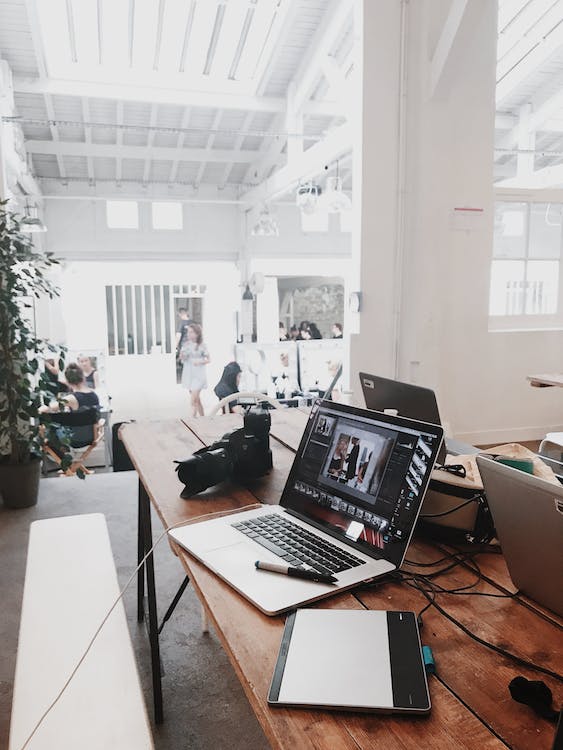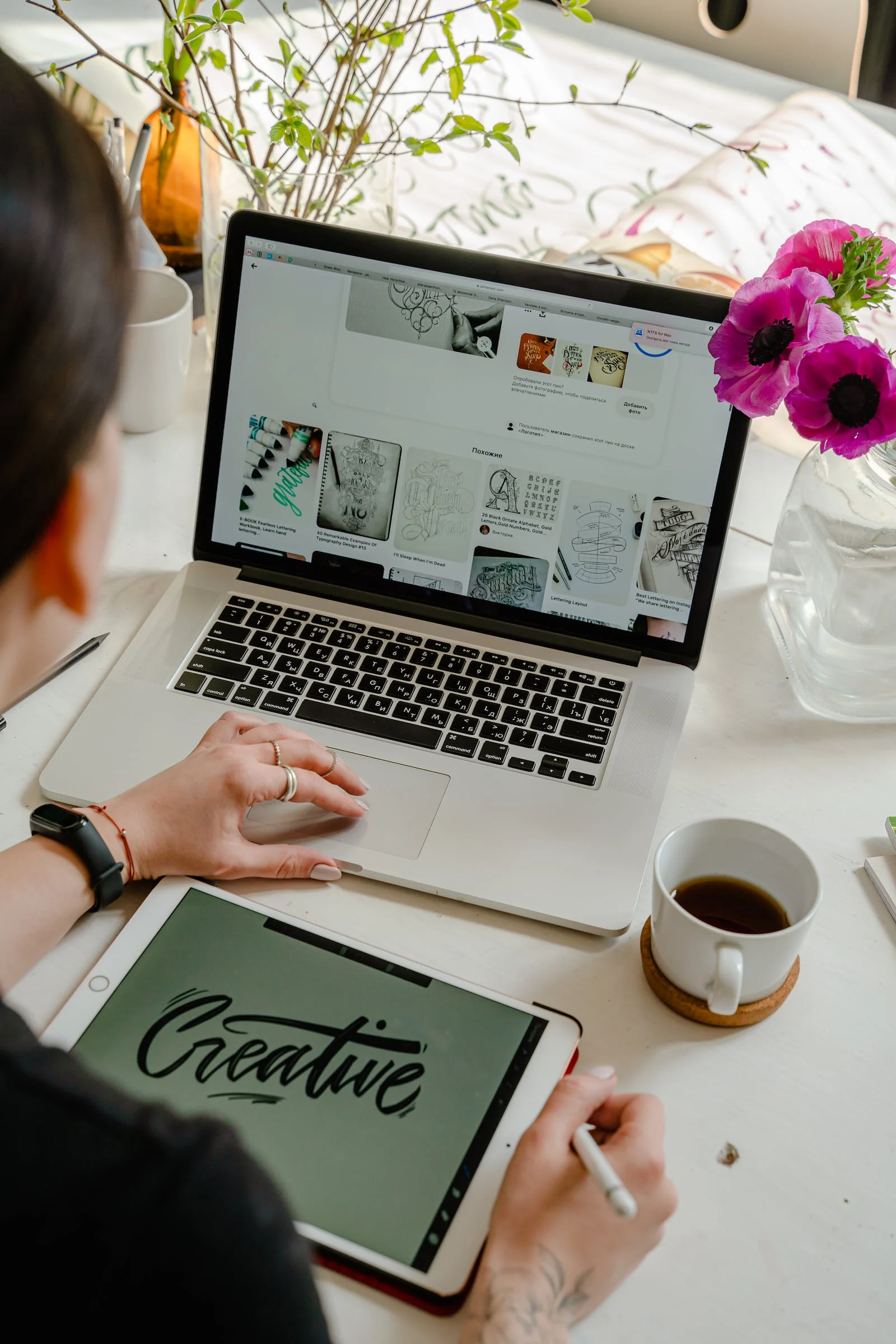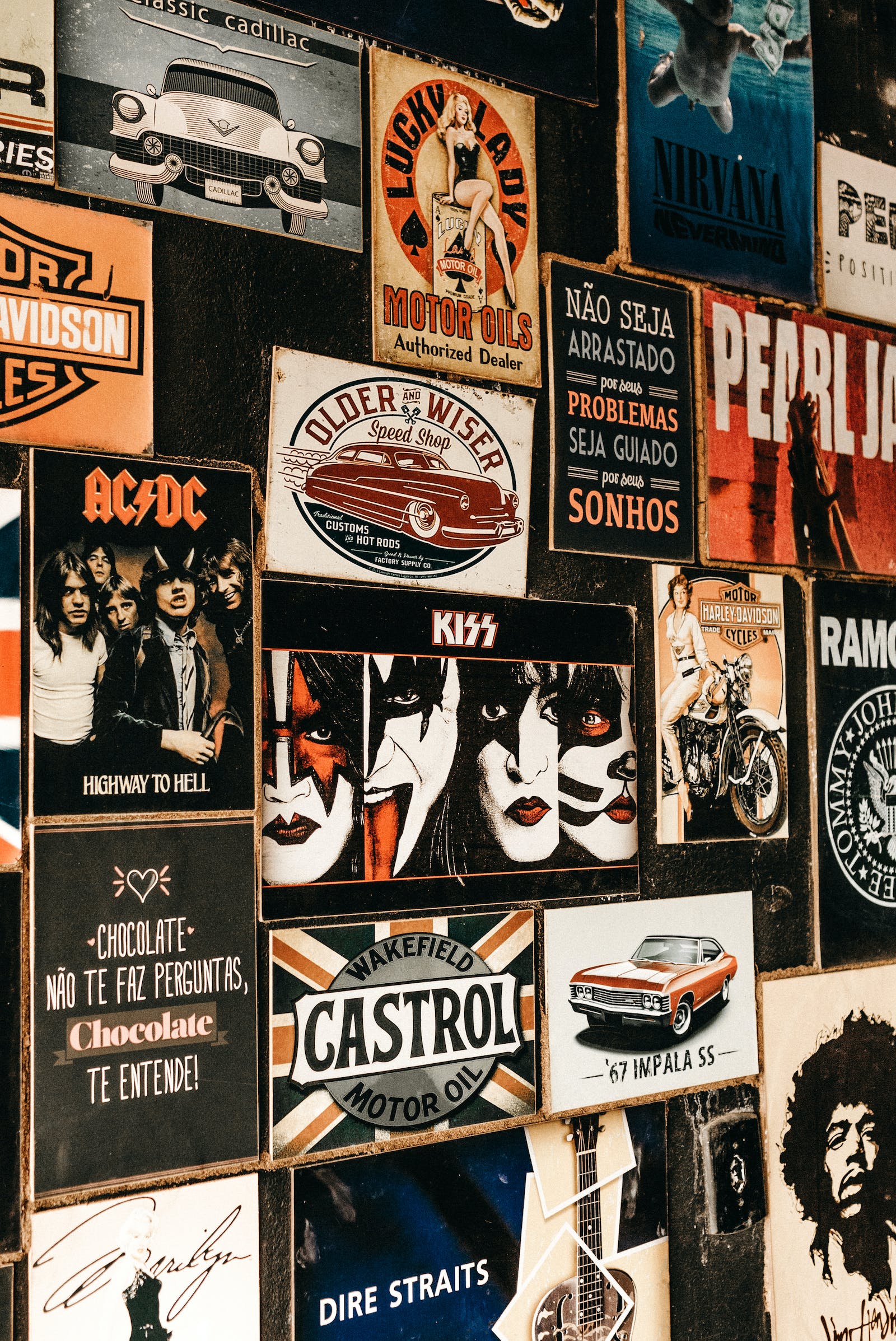Learn more about Graphic Design & our classes
What is Graphic Design?
Graphic design is the art of communicating ideas through visual concepts to educate, inform, or engage a consumer. Graphic designers create graphics using computer software or by hand. Examples of graphic design include print products, such as business cards, brochures, and product packaging. Examples of graphic design in digital format include websites, logos, and user interface mockups.
Is the graphic design industry growing?
The graphic design industry will grow by about four percent between 2016 and 2026 according to the US Bureau of Labor Statistics. In 2016, there were over 250,000 graphic design jobs in the nation. Graphic designers should have both training and a design portfolio to be a competitive candidate for a graphic design position.
What skills do graphic designers need?
Graphic designers use a variety of skills and tools to complete their work. Some graphic designers do sketches and hand drawings, but most rely on software programs to create their art. The most popular tools used by graphic designers include:
Additional requisite skills include creativity, an eye for good design, and the ability to translate ideas and concepts into visual representations that convey a brand’s message.
What do graphic designers do?
Graphic designers work in just about every industry, designing business cards, websites, and any other visual products manufactured by a company. While graphic design jobs used to require a steady hand and skill in drawing, today’s designers rely on computer programs, creativity, and digital savvy. Everyday graphic design tasks include the following:
- Product packaging
- Cartoons
- Logos
- Business cards
- Websites and blogs
- Stationery
- Infographics
- Presentations and reports
- Newsletters
- Flyers, posters, and advertisements
- Digital ads, web banners, pop-ups
- Social media posts
- Mobile applications
What Jobs Can You Get as a Graphic Designer?
It’s important to note that at least 20% of graphic designers are self-employed according to the US Bureau of Labor Statistics. Upon earning a degree in graphic design, earning a certificate, or developing a portfolio, many graphic designers choose to work freelance or start an agency to do small graphic design jobs for companies that don’t need a full-time graphic designer.
Experienced designers may work as a Creative Director or Lead Designer. Some graphic designers pursue additional training and work as User Experience (UX) or User Interface (UI) Designers specializing in user-centric design. Other designers learn to code and also work as front-end developers that design websites.
Fremont College has outlined a few of the most common roles that graphic designers pursue:
- Web Designer - Web designers use text, photos, and graphics to create a visually appealing website that entices prospective customers. A graphic designer may use web design tools or learn to code a site with HTML, CSS, and other languages.
- Package Designer - A package designer may design labels, boxes, and containers for products that represent the brand, but also display relevant information about the product, such as nutrition information, or instructions.
- Digital Designer - A digital designer designs materials for the web including social media posts, websites, blog posts, website ads and banners, reports and online newsletters.
- Logo Designer - Logo designers create logos to represent a concept, product, or service. The logo design may also include a business card or stationery design with the logo.
- Brand Identity Designer - The brand identity designer ensures all visual elements of a brand align with the brand’s target consumer and mission statement. The brand concept includes any visual representation of the brand, both digital and in print.
- Layout Designer - A layout designer formats books, magazines, newsletters, reports, and other text documents with photos and graphics. The layout designer is responsible for presenting the information in a coherent and aesthetically-pleasing way.
- Animation Designer - Some graphic designers use visual design, text, and audio to create videos, commercials, and other interactive designs. Designers may use a video creation tool or code if they have the ability.
What is the Future Outlook for a Graphic Designer?
An emerging trend in the graphic design industry is the focus on data and analytics. With tools like Google Analytics and Instagram Insights, it’s easy to see which designs are most popular among consumers. Graphic designers with a penchant for analyzing data and using this knowledge to create data-driven design will surely find an abundance of work in the industry.
Adobe Photoshop
Created to edit photos, Adobe Photoshop has become the go-to program for many graphic design tasks. As the world has shifted from print to digital, many people have begun to use Photoshop for tasks beyond editing photos. Photoshop is the most popular of Adobe’s programs and a must-have that every graphic designer should learn how to use.
What Does Photoshop Do?
Before learning Photoshop, it’s helpful to know a few essential details about what the program can do. First, Photoshop was designed to edit photos. If you want to remove a blemish, change colors, or alter a photo in any way, Photoshop is your best choice. Photoshop is a raster program, meaning that the images are represented by millions of dots of color called pixels. Television and computers also use raster graphics, which is why Photoshop works well for images with special effects.
Adobe Illustrator
Adobe first released Illustrator in 1987, three years before the release of its most popular program, Photoshop. Illustrator’s main strength is the creation of vector graphics, an easy-to-resize format for digital artwork. Illustrator can be used to create ads, draw or digitize graphics, develop logos, and design business cards. In recent iterations, Adobe has improved Illustrator’s ability to typeset text, resulting in some designers’ preference for Illustrator to Adobe’s text-layout program, InDesign.
What Is the Main Purpose of Adobe Illustrator?
The primary purpose of Adobe Illustrator is to draw, design, and edit vector graphics. A vector graphic could be an illustration of a concept, a logo, or a graphic representation of text for a business card. The critical thing to note about vector graphics is that resizing is easy to do without stretching or comprising the quality of an image. For example, if you create an abstract design for your business card, the design can be enlarged to use on a t-shirt, and also reduced to use on a pen or stationery without sacrificing image quality.
Adobe InDesign
Released much later than its counterparts Adobe Photoshop and Adobe Illustrator, Adobe InDesign was created to manage document layout. Publishers, newspapers, and magazines needed a way to design text-heavy documents and preserve the layout for multiple issues of the same style at a later date. InDesign was created and released at a time when print books, newsletters, and magazines dominated the world of knowledge. Fortunately, InDesign is a valuable tool that still has retained much value in the modern world of digital publishing, as it can be used to design the layout of eBooks, digital magazines, PDF presentations or brochures, and other multi-page documents.
What Adobe InDesign Is Used For
InDesign is used to create and manage text layout. The program is often used in conjunction with Adobe Illustrator and Adobe Photoshop to develop visually-appealing texts. For example, if you are designing a PDF presentation in InDesign, you might use Illustrator to create the logo that appears on the first page of the presentation and Photoshop to create and crop company headshots in the biography section of the presentation. For documents that are mostly text and exceed one page, Adobe InDesign is likely your best choice.
Get Started in Graphic Design or Earn a Certificate
Start learning the key graphic design tools and applications, or earn a graphic design certificate while building an impressive portfolio to show prospective employers. Discover more graphic design courses at our affiliate, Noble Desktop, NYC's best graphic design school.
Graphic Design Classes in NYC
Graphic design, the art of communicating with a mass audience, is a vital component of almost every aspect of a business or insituttion’s attempts to interface with the public. Whether it is in advertising, branding or persuasive rhetoric, being able to create compelling, memorable graphic designs, logos, infographics and brand markers is vital to long-term success. Learning graphic design is a great way to parlay a creative passion into an in-demand career field and there are no shortage of classes available to NYC residents looking to improve their design skills and learn digital art tools.

Why Learn Graphic Design in NYC
NYC is one of the busiest economic centers in the world and easily the largest in the United States. This means that it is home to some of the largest companies on the planet and hundreds of new businesses are starting up everyday in the city. All of these businesses need graphic designers to help them establish their brand identity and create visual iconography that they can put on everything from websites to business cards to product packaging. Learning graphic design skills will open up career opportunities in a range of different fields and industries and give artists the chance to freelance or find stable studio employment.

Graphic Designers are professionals who are tasked with creating memorable, striking or rhetorically persuasive visual content in traditional print mediums. They will most often use digital art tools like Photoshop, Illustrator or InDesign and they will be tasked with creating everything from book layouts to campaign flyers to product packaging to public service infographics, depending on their clients or employers. They tend to work as freelancers or in design studios that contract out work but some larger companies and corporations will hire in-house graphic design teams to work on their larger projects. In NYC, a Graphic Designer earns approximately $64,000 annually, which is 15% above the national average.
More experienced designers may find work as Design Directors, professionals who oversee large scale design projects like new product launches, rebranding efforts or large scale advocacy campaigns. These designers are tasked with fulfilling the project’s creative vision and they may be closely involved in the brainstorming and development portions of the project. They will need to understand the principles of design and they will need to understand how to manage the human aspect of a given project. Design Directors tend to start their careers as Graphic Designers and either find work in a studio or in-house team or start their own studios. In NYC, the salary for Design Directors averages approximately $128,000 annually.
NYC also has one of the world's most diverse and largest art communities, making it a fantastic place for aspiring artists to network and thrive. Even if you aren’t interested in becoming a professional graphic artist, learning how to use digital art tools can help expand the creative canvas upon which you can work and can give you new perspectives on the kinds of art you want to create. Plus, since these tools are relatively easy to learn for beginners, hobbyists or amateur artists can easily start creating their own designs and projects. Thus, for example, if you are holding an event or a concert, learning Photoshop can help you make more effective advertising materials.

Best Live Graphic Design Classes in NYC
Students looking to start new careers in the field of graphic design should consider enrolling in the Graphic Design Certificate program, taught by NYIM Training in conjunction with Noble Desktop. This course aims to provide students with professional, career-focused education in graphic design principles and technical aspects. Students will start by learning important design theories, such as theories of color, composition and typography, to make informed decisions about the approaches they take to design. Then, students will get practical hands-on training using Adobe Photoshop, Illustrator and InDesign, all of which are industry-standard tools. This training will mirror the kinds of real-world projects that students can expect to work on as professional Graphic Designers, and these projects can be refined as part of a student’s professional design portfolio. Since this is a career-focused training program, lessons will be geared towards practical career skills, and students will be able to work directly with experienced design specialists in one-on-one career mentoring sessions.
NYIM Training also offers more targeted training seminars for students looking to learn the fundamental or advanced features of common graphic design programs. These courses, which include the Adobe Photoshop Bootcamp, the Adobe InDesign Bootcamp and the Adobe Illustrator Bootcamp, aim to teach students how to utilize these tools in their professional or personal lives. In these classes, students will focus on the important features of these applications and will learn how they are most frequently employed in design projects. Then, students will get hands-on experience using the tools to manipulate photos, create page layouts and design vector graphics assets. These courses are excellent introductions to the world of graphic design, though anyone looking to start a career in graphic design will likely need more advanced training.
NYC Career Centers offers an in-person Graphic Design Portfolio Bootcamp that provides students with a space to work on developing their own professional portfolio for clients and employers. In this class, students will work on hands-on design projects and receive and provide feedback on their work and their classmates’ work. With this feedback, students will then revise their portfolio materials to strengthen their work and demonstrate their ability to receive and address feedback. This is a career-oriented program, so students will be encouraged to work on projects that will maximize the visibility of their work and make their portfolio as attractive to employers and clients as possible. This is an advanced course, so students are expected to already have a firm knowledge of tools like Photoshop, Illustrator and InDesign.
The Manhattan Edit Workshop offers two courses for aspiring photo editors in their Adobe Photoshop Level 1 and Adobe Photoshop Level 2 courses. These classes aim to introduce students to the process of editing and manipulating pixel-based images using Adobe’s industry-leading photo manipulation software. In the level 1 course, students will be introduced to the basic tools of the application, including basic color and photo correction techniques, the use of the layers tool to make subtle manipulations to an image, masks and channels and quick fixes for common issues. In the level 2 course, students will learn advanced compositing skills, and how to work with vanishing points, the use of smart objects, adjustments layers and filters, and the use of the mixer brush. Once students have completed these courses, they will have a firm grasp of all of the most significant uses for Photoshop.
Younger students (between grades 6-12) can learn to use Photoshop in One River School’s Learn to Use Adobe Photoshop course. In this course, students will work through a series of five mini-projects teaching them how to use Photoshop to edit photos, manipulate images and create new assets. This is a beginner-friendly course, so students don’t need any art or photography background in order to attend, making it a great opportunity to explore new skills and learn about a versatile digital art platform. This course runs for five afternoons and is a great summertime activity for younger students looking to start exploring their creative sides while becoming more proficient with technology.
Another option for high school students looking to learn graphic design skills is NextGen Bootcamp’s Graphic Design Summer Program NYC course. This program, which is open to students in grades 10-12, is an ideal opportunity for students to spend part of their summer learning the principles and techniques of graphic design. In this class, students will get to flex their creative side while learning principles of design and composition and working on hands-on Photoshop, Illustrator and InDesign exercises. This course is a great place for students to learn digital art and design skills, and it is a solid investment for students looking to continue with their digital art education. Students may even be able to use the projects that they design in this summer program as part of their application materials for college-level art programs.





























